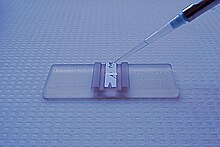This article has multiple issues. Please help improve it or discuss these issues on the talk page. (Learn how and when to remove these messages)
|



The hemocytometer (or haemocytometer, or Burker's chamber) is a counting-chamber device originally designed and usually used for counting blood cells.[1]
The hemocytometer was invented by Louis-Charles Malassez and consists of a thick glass microscope slide with a rectangular indentation that creates a precision volume chamber. This chamber is engraved with a laser-etched grid of perpendicular lines. The device is carefully crafted so that the area bounded by the lines is known, and the depth of the chamber is also known. By observing a defined area of the grid, it is therefore possible to count the number of cells or particles in a specific volume of fluid, and thereby calculate the concentration of cells in the fluid overall. A well used type of hemocytometer is the Neubauer counting chamber.[2]
Other types of hemocytometers with different rulings are in use for different applications. Fuchs-Rosenthal rulings, commonly used for spinal fluid counting, Howard Mold rulings used for mold on food and food packaging products, McMaster Egg Slide ruling used for counting microbial eggs in fecal material, Nageotte Chamber ruling for counting low levels of white cells in white cell-reduced platelet components, Palmer Nanoplankton ruling for counting smaller plankters. Petroff-Hausser counter using Improved Neubauer rulings is used for bacteria or sperm counts, and is offered with varying chamber depths. The Sedgwick-Rafter Cell ruling in a hemocytometer is primarily designed for use in the microscopy of drinking water.
- ^ Absher, Marlene (1973). "Hemocytometer Counting". Tissue Culture. pp. 395–397. doi:10.1016/B978-0-12-427150-0.50098-X. ISBN 9780124271500.
- ^ "Fig. 8. Views of an improved Neubauer ruling hemocytometer slide. (A) Top view..." ResearchGate. Retrieved 29 March 2018.